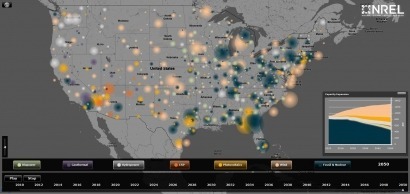
A report published this month by the NREL entitled the Renewable Electricity Futures Study (RE Futures), is an initial investigation of the extent to which renewable energy supply can meet the electricity demands of the continental US over the next several decades.
The study explores the implications and challenges of very high renewable electricity generation levels – from 30% up to 90%, focusing on 80%, of all US electricity generation from renewable technologies in 2050.
While the authors of the study conclude that such high levels of renewable electricity generation are possible, “the unique characteristics of some renewable resources, specifically geographical distribution and variability and uncertainty in output, pose challenges to the operability of the nation's electric system”.
RE Futures provides initial answers to important questions about the integration of high penetrations of renewable electricity technologies from a national perspective, focusing on key technical implications. The study explores electricity grid integration using models with unprecedented geographic and time resolution for the contiguous United States to assess whether the US power system can supply electricity to meet customer demand on an hourly basis with high levels of renewable electricity, including variable wind and solar generation.
Key findings
RE Futures, funded by the US Department of Energy's Office of Energy Efficiency and Renewable Energy, is a collaboration with more than 110 contributors from 35 organizations including national laboratories, industry, universities, and non-governmental organizations.
As the most comprehensive analysis of high-penetration renewable electricity of the continental United States to date, the study can inform broader discussion of the evolution of the electric system and electricity markets towards clean systems. RE Futures results indicate that renewable generation could play a more significant role in the US electricity system than previously thought and that further work is warranted to investigate this clean generation pathway.
Another output of the study is a series of dynamic visualisations of how renewable and conventional energy capacities could ramp up between now and 2050 as shown in the inset.
[Inset: Visualisation of transformation of the Electric Sector showing installed capacity in 2050]
For additional information:

